Bora Tuning Modifications
"This should not Bora you."
Viewed and often dismissed by many as a Golf with a boot this car has a lot to offer. This is technically a Jetta A4 but was branded a Bora in most regions and succeeds the Jetta A3 and was succeeded by the Jetta A5 and A6 Jetta.
It has the convenience of a larger saloon car but retains the handling characteristics of the Golf and thankfully most Golf parts will fit this Bora ensures a large aftermarket upgrade range.
If anything the extra weight over the rear balances the car more and makes cornering a little more predictable.
Most of the engine options that come on the Golf are available in the Bora line up. Our current best pic for your Bora Tuning project is the 180bhp 1.8T engine. With a remap and the addition of the larger KO4 turbo you will see power gains reaching 300-350bhp!

VW often skimped on the performance options on the more powerful options. For example on the 180bhp Golf you get larger more meaty brake disks. As the Bora is somewhat heavier this seems to be an odd omission.
The suspension is also skewed towards a soft comfortable ride, we would recommend getting some adjustable shocks fitted and lowering the car by about 30mm.
The wheels have a lot of potential with one of our members fitting the wider wheels from an Audi TT. As you can imagine there is a wide selection of aftermarket wheels for the VAG range of cars.
We would strongly urge you to look after the oil change schedule, particularly on the 1.8T as it is prone to sludge build up and oil pump failure. The diesel engines have a lot to offer as well but for some reason the 1.9 TDi from the Golf GTi with 150bhp was not an option. All the larger powered diesel engines respond very well from a remap.
Bora Engine Tuning Options.
The following modifications are usually performed by our members, decide how far you want to go before you begin.
Getting the right mods for your planned usage of the car is vital. Stage 3 (competition) mods just don't work well on the road.
Please watch our video which covers the 5 principles of tuning your car. Be sure to keep up with our latest YouTube content and subscribe.
Best Engine Mods for your Bora
- Turbocharger Upgrades - forced induction is the most efficient approach to increase air supply, allowing you to burn more fuel and make more power. It is one of the most costly upgrades but provides the best gains.
- Intercooler improvements - whilst not adding power it will deliver your power for longer resisting heat soak, an essential on a tune/remap or heavily modified Bora.
- Braking mods - improve the handling of your Bora with better discs and pads.
- Map Tunes - engine tuning/remapping provides the most advantage in terms of cost savings, aftermarket ECUs, and piggyback ECUs are all alternatives.
- Intake and Exhaust - Note that on their own these mods will NOT ADD POWER in most cases, but they can help enhance power after other mods by removing the restriction.
Bora Tuning Stages
Typical stage 1 mods often include: Exhaust, Panel air filter, Engine Tunes/Remapping, lighter flywheel
Typical stage 2 mods often include: Fast road cam, ported and polished head, fuel injector & fuel pump upgrades,
Typical stage 3 mods: Engine balancing, forced induction (turbo/supercharger), Internal engine upgrades (pistons/head/valves), competition cam.
Engine swaps are quite popular mods for this model, here are engine guides to all the VAG engines we've covered.
- 1.4 1.5 TFSi tuning
- 1.4 TSi/TFSi/Twincharge tuning
- 1.8T engine Tuning
- 1.8 & 2.0 TFSi (mk1) Tuning
- 1.8 2.0 TFSi (ea888) Tuning
- 2.0 TFSi carbon issue & care guide
- 2.5tfsi tuning
- 3.0 V6 24v TFSI Tuning
- 2.8 V6 30 valve, 24 valve 3.0 V6 30v and 3.2 VR6 Tuning
- 3.6 VR6 Tuning
- 1.6 TDi tuning
- 1.9 TDi tuning
- 2.0 TDI 140-170 tuning
- 2.0 TDI tuning (EA188)
- 2.5 TDI tuning
- 2.7 & 3.0 TDI tuning
One of the best mechanical mods you can do on the Bora especially the NASP version is to fit a fast road cam. Don't forget to uprate the fuelling when you are increasing the power - it makes the car more thirsty.
A fuel pressure boost valve will make the car more responsive and will particularly improve throttle response. Uprating the injectors is another beneficial modification and will deliver sufficient fuel.
Uprate the fuel pump to cope with the extra fuel requirements of your tuned Bora.
VW Bora Turbo Upgrades and Mods
The VAG company has introduced a range of turbocharged engines to its cars in recent years, so let's take a look at these turbocharged engines, their differences, and your best upgrade options. Read our comprehensive guide to VAG group turbos..
We also take a look at turbo power limitations. You can push a turbo over its safe limits, but the turbo's lifespan will be reduced. You will hear a whining or siren sound before the turbo fails, followed by smoke.
You should attempt to replace it at this time. A turbo failure may cause considerable engine damage, especially if a compressor fails.
DO NOT FIT AN ATMOSPHERIC DUMP VALVE TO THE BORA ENGINES, You'll throw error codes and the engine will run lean.
Which turbochargers were installed in the VW Bora?
Comparison of K03, K03s, and K04 The K03 turbo was available from 1996 to 2000, when it was replaced by more powerful K03s.
Engines On the early 1.8T engines, the K03 turbos are used. These engines use a MAF sensor, a cable-operated throttle, and smaller injectors. K03 turbos are used in AUM engines equipped with MAF and MAP sensors.
These engines have a more advanced drive-by-wire throttle configuration, which improves response time, fuel economy, and performance. Stigan and BorgWarner are two of the most prominent manufacturers of K03 turbos.
Variations in KO3/KO3s
The most notable difference between turbos is the number of blades. The K03 has eleven, whereas the K03s has eight, the K03s blades are larger and spool up more quickly and provide more top end power.
The actuator that opens the turbine bypass valve is typically a 65N or 85N, however some models included a two-port actuator.
Because 180hp engines consume more boost, they need higher-quality actuators with more opening force. To increase power, several hybrid turbo manufacturers utilise a larger compressor on the intake side.
K03
When it comes to hp the K03 has the least amount of boost provision, but with the right add-ons, it can exceed 190 horsepower. You could get more, but the turbo will wear out faster so consider this a safe limit.
K03s
The power of the K03s is more than that of the K03. The safe limit for K03s is 215 horsepower, which most people achieve. This turbo has been advertised to generate more than 250 horsepower, so there is plenty of room for error.
The K03s provides a safe performance improvement of at least 25 horsepower over the K03, with more available if you are prepared to reduce turbo life or undertake more maintenance.
What about the K04? How does it stack up against the K03 K03s?
K04 Outperforms both the K03 and K03s, and unlike the K03 and K03s, the K04 is physically larger and generates more power and over a longer RPM range. The K04's performance can approach 350 horsepower with the right hardware, whilst the KO4's safe limits are about 220hp.]
K03s and K03S turbos were smaller in size than K04s. Despite having less power, they took up less space when fitted than the K04 which is why they are so popular, all turbos are bolt on upgrades, providing you have the right manifold/headers - the transverse and longitudinal engines vary.
Why Should You Replace your Boras Turbocharger?
Here are some of the reasons why people change or upgrade their turbos: One of the most significant power boosters is a turbocharger upgrade making this a primary incentive.
Also turbos lose performance with time and must be replaced. Newer turbos feature more add-on options and incorporate new technology so it makes sense to upgrade with the best available.
VW Bora Turbo Upgrades That Work Well
We recommend that you carefully investigate your source since there are many bogus and low-quality turbo units on the market. If you cheap out, and install a low-cost turbo upgrade, you'll be doing it again in six months.
AFTER A TURBO SWAP, Remapping IS REQUIRED.
Failure to do so may result in lean running or limp home mode, as well as fault codes. A factory ECU will only slightly lower fuelling, and you'll be wasting the opportunity.
Here are alternatives to the stock K04 turbo:
- SH Stigan 847-1435 SKU 40-30002
- AW BorgWarner 53049500001 SKU 40-30003
It is the same as swapping a VAG turbo to a different model. While the technique varies from vehicle to vehicle, various stages may be included to further boost your gains:
- Changing the diameter of the exhaust pipe
- Catalysts with less restrictions
- Changing out the mufflers
- The fuel pump
- A brand new booster controller.
- Intercoolers and various types of cooling systems
- A wastegate modification
- Fuel injectors have been replaced.
The following list may seem onerous at first look, however, the steps necessary will differ based on the vehicle and your power goals. Aside from the aforementioned factors, the engine compartment architecture and layout have an impact on how difficult it is to transfer a turbo from a different model with space being a limiting factor.
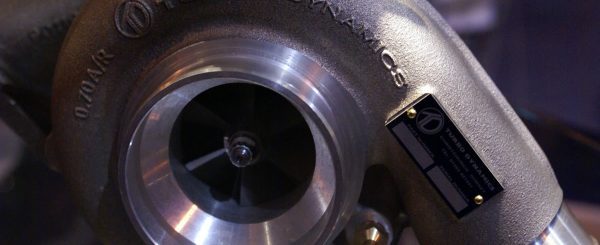
VW Bora Turbo Hybrids
Why Are Hybrid Superchargers Available? While Stigan, IHI, and BorgWarner all manufacture turbochargers, many people believe that hybrid turbochargers are the best route for tuning projects.
A Hybrid is produced by combining high-performance parts from several suppliers and can be tailor made for your needs. These hybrid turbochargers are intended to outperform factory turbochargers in longevity, spool up time, and overall boost.
Do VW Bora Hybrid Turbos Perform the Same as OEM Turbos?
To achieve extreme performance, a hybrid turbo may have a single component or even the whole OEM turbo replaced. Hybrid turbos are unique in that they are not serialized. While these turbochargers seem to be stock, the upgraded inner components promise much enhanced performance.
Hybrid turbos provide improved performance.
Because they blend the best of the greatest characteristics, hybrid turbos beat regular turbos in terms of responsiveness and performance.
A well engineered hybrid turbo boosts pressure and flow while maintaining a safe turbine speed.
This extends the life of the components. You get what you pay for with hybrid turbos. Stock turbos need several compromises, but the fundamental advantage of hybrid turbos is that you get what you pay for.
Constraints and expected power gains for your Bora
Mods and a nice REMAP K03s Should generate 210-220 horsepower with a Stage 1 tune/remap (air filter, exhaust, bolt-on upgrades).
Stage 2 engine tuning/remapping (cat replacements, fueling upgrades, and intercooler changes) may result in 230-250 horsepower.
Remember that a Stage 2 engine tuning/remapping necessitates the use of an intercooler to reduce air temperature; otherwise, the power output will be much reduced.
Bora K04 REMAPPED
Stage 1 improvements provide the K04 turbo with around 250-260 horsepower, however, we've seen some with more.
An improved high-pressure fuel pump; a new FMIC (front mount intercooler); high-quality gasoline (98+ Ron); and a high-performance clutch are all included (your OEM clutch will slip).
Bora Intercooler Upgrades
The closeness of the cold intake charge to the high exhaust temperatures inside the turbo is one issue with turbos and adds a lot of heat.
Also remember that the actual compression of air causes a significant increase in air intake heat, thus even supercharged engines will benefit from an intercooler. If you've ever touched the nozzle of a tire pump, you'll know that compressed air produces heat.
We learned in chemistry and physics that the colder the air, the more oxygen it contains. What is the significance of this? You need oxygen to burn gasoline, and the more oxygen you have, the more fuel you can burn, which boosts the car's power output.
An intercooler functions like a radiator, allowing the intake air charge to be cooled before entering the engine. An intercooler should be installed in front of the radiator so that it can benefit from all of the cold air.
It would be installed after the air intake filter and before the turbocharger or supercharger, which is where the majority of the heat is generated. Front-mounted intercoolers lie in front of the radiator in most automobiles, and as a consequence, they provide better air conditioning than top-mounted intercoolers.
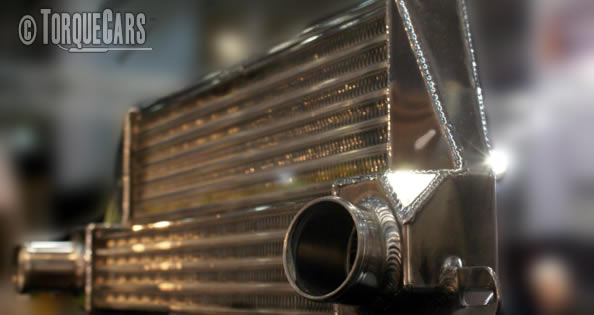
As a matter of general approximation, for every 100 horsepower, 3 litres of intercooler capacity should be used. This is clumsy, but it seems to work for most automobiles with 150 to 400 horsepower! In actuality, having an intercooler that is too big will obstruct airflow, thus it's critical to acquire the right size for the job (this is something that can be discussed in more detail in our forum.)
It's not always true that bigger is better! We at TorqueCars would estimate a pressure reduction of.5 to.9 psi for a boost level of 15PSi, with certain applications losing 1.3 psi in the worst case situation.
(Just as rising pressure causes the temperature to rise, reducing air temperature causes pressure to fall, so don't blame the intercooler design for the full loss of pressure.)
Weight is always a concern in performance automobiles, and many aftermarket intercoolers are both lighter and give far higher performance benefits than their original counterparts.
Bora Brake Upgrade Modifications
Larger brake discs spring to mind, but don't forget about the pads - they're definitely more vital than the discs, and faulty or poor quality pads may impair the handling of your Bora.
Brakes are essential because going rapidly necessitates the ability to stop quickly. A brake converts kinetic energy into heat by pushing a friction pad on the disc.
The car's forward motion is slowed when the head disappears. Brake heat accumulation is visible in nighttime motorsports, as the brakes glow with heat after extensive usage.
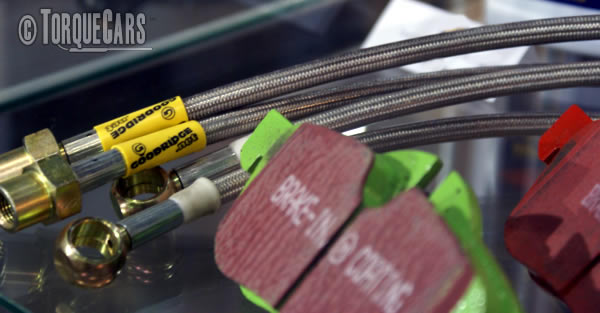
When you press the brake pedal, the force is transmitted to a magic box called a servo, which utilises engine power to amplify your foot pressure, giving you a wonderful progressive experience.
The increased pressure is delivered to the friction pads through a brake fluid-filled tube (liquids do not compress like air).
The braking fluid itself may grow fairly hot as it approaches the hot brake pad end, placing extra demands on it.
Brake fluids are hygroscopic (attract water particles) and may boil at high temperatures; air bubbles in the brake fluid cause a spongy feeling at best and can completely disable the brake at worst, which is why you should replace the fluid on a frequent basis.
(For further information on this topic, see the page on Brake Fade.)
Braking heat is dissipated by the pad over the discs, therefore the colder the disc, the better.
The middle channel on the vented disc increases the surface to air ratio, resulting in better and quicker cooling.
By boosting the airflow yield and minimising gas buildup between the pad and the disc, drilled discs help keep the pads 'clean and sharp.' Larger discs will provide greater cooling, although they may need a different alloy wheel.
Bora Brake Pad Upgrades
Materials for a pad High-friction brake pads, on the other hand, are required, even if they cause noise and dust.
Racing pads are constructed of a high-friction material that performs best at higher temperatures.
Race grade brake pads are inappropriate for road usage if braking is done on cold pads or in short bursts since they only operate when extremely hot.
Fast road pads from Pagid and Black Diamond are a decent balance between braking and wear, according to TorqueCars.
Although driving technique can effect pad and disc wear, certain performance brake pads emit practically no brake dust and last longer than the standard pads I was using. When the ABS senses a lockup, the brake is released until the wheel rotates again.
This reduces the braking force to the degree of grip you now have. Due to differences in weight distribution, steering lowers braking effectiveness and reduces wheel locking resistance.
If you're not a mechanic, you won't be able to do this safely. To minimise the risk to yourself and others, Torquecars recommends leaving brake maintenance to the pros.
Upgrade your Bora Braking System.
The stopping power of an automobile may be enhanced. Normally, the discs and pads would be upgraded. Because a bigger disc has greater friction and disperses more heat, you will see immediate results.
You will have more braking sensation and be able to identify the moment of lockup easily with a huge disc conversion kit.
If you have a simple family vehicle with tiny discs, you can get brake discs and servos from a performance model in the same family quickly and affordably.
On a compact family vehicle, powerful brakes are usually standard (if they fit into the alloy wheels or you need to have bigger rims).
Because little vehicles and bigger executive cars frequently share components, a little research and conversation with our forum members may assist. Because most hubs are interchangeable, brakes from VW, Audi, Porsche, Skoda, and Seat are interchangeable.
Calipers (which apply the clamping force) and pistons are the next two items on the list (which push the calipers).
The more pistons you have, the greater the clamping force, which allows you to use bigger pads.
It's not as easy as making a dog bone adapter to fit them into factory (or bigger) discs and replacing the single piston sliding callipers!
The total volume of brake fluid used must match the quantity used in the master cylinder of the donor vehicle. Before the brakes engage, the pedal stroke and feel will be changed, and the pedal will most likely slide closer to the floor.
The OEM master cylinder may need to be overbored or replaced with a bigger one to match the source vehicle's master cylinder capacity.
Increase the pad, caliper, and piston count to enhance the impact of upgrading the discs.
Bora Remapping
What is it about OEM maps that makes them so bad? Local variations in fuel emission rules and temperatures almost always need a fudge of the one-size-fits-all strategy.
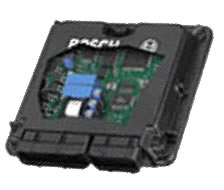 To accommodate for temperature changes, small problems, and poor weather, manufacturers create timing maps with a considerable margin of error. Because the CO2, HC, and NOx emission goals of certain nations varied, a fudged technique is required.
To accommodate for temperature changes, small problems, and poor weather, manufacturers create timing maps with a considerable margin of error. Because the CO2, HC, and NOx emission goals of certain nations varied, a fudged technique is required.
Manufacturers include a considerable leeway because they do not want consumers to be inconvenienced by mechanical problems or poor fuel efficiency.
The fact that various nations use different fuel grades and have differing degrees of bad weather adds to the wrangling that must be done to keep all automobiles running smoothly throughout the world.
Each car's power varies by 20bhp depending on how well the components are machined and installed. They employ a one-size-fits-all strategy rather than examining each vehicle individually and creating a specific timing map.
Remaps are used by manufacturers to make several power versions of the same engine, which lowers insurance costs and improves fuel efficiency.
When you consider that the typical TorqueCars reader will be upgrading components, it's easy to see why a tune/remap is a good idea.
In addition, user negligence is taken into account, such as infrequent service, dirty plugs, bad leads, clogged air filters, partly blocked injectors, and so on. And so on. Who is it that remaps? Remapping is a good idea for everyone who has improved their engine.
Remaps are also recommended for all new turbocharged engines, which offer 20-30% more power. For turbocharged automobiles with electronically controlled fuel injection, TorqueCars highly advises a remap.
Issues From Remapping - What are the extra expenses that aren't obvious?
Prepare to service your Bora more regularly, doubling the service frequency in certain cases. You must be prepared to repair components that fail due to the additional effort they are performing if the map was adjusted for high octane gasoline.
When an engine is adjusted for higher power, components are placed under additional stress and will need looking after.
Engines weaker areas typically reappear months after a remap. See our tune/remap troubleshooting guide for more information.
Any turbocharger or clutch issues will usually become apparent after a remap.
Turbos may also wear out, and important components such as pistons and bearings must be properly maintained, and the clutch is less robust. What about engine tuning/remapping NASP? If you don't have a turbo, a tune/remap will only add a few BHP (10 percent is typical).
TorqueCars recommends that non-turbo vehicles improve everything else first (cams, pistons, increase compression, engine balance, air intake, exhaust, head work, bigger valves etc...)
Following that, you may want to consider a tune/remap to help you get the most out of them.
Engines with turbochargers need special attention.
A tune/remap may also raise boost from lower in the rpm range, making the turbo run quicker and hotter and stop it from cooling down which is not always desirable, plus you get a lot of wheelspin.
If you don't let the turbo cool before shutting off the engine, the oil may deteriorate, necessitating a costly turbo repair. A turbo timer may also help keep the engine running until it cools down.
Claims of peak power should be taken with a grain of salt. When comparing maps, keep in mind that certain tuners are known to create a power blip or spike in order to draw attention and capture those headline power statistics.
See the graph below for an example of what we're talking about.
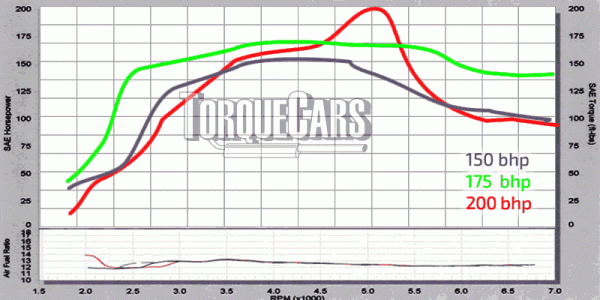
Rather, concentrate on the overall torque curve. More power at the bottom deactivates the turbo and produces traction problems, while more power at the top deactivates the turbo and components.
The red plot indicates an increase in power but a decrease in power everywhere else, while the green trace shows a steady rise in power across the RPM range.
It also displays peak power at 4000rpm, which is excellent for an engine that redlines at 7000rpm, giving you a good distribution of additional power where you need it the most.
We want to see a lovely smooth torque climb over the whole rpm range on a chart, with no dips or troughs.
To find out whether the map has ever been tried or analysed, go to the company's clandestine office, where you'll typically find someone with a laptop tinkering with the fuel and spark advance tables, hoping for the best, but never seeing the vehicles they're tuning.
Bora Air Intake and Exhaust.
Now we move on to the intake and exhaust and ensure proper flow through the engine. Maximum power gains come from a full induction kit. On small engines you will actually lose low down power so we suggest you use a panel air filter instead. A good sports exhaust is essential to balance an induction kit, just adding an induction kit on it's own will do little to increase your power.
Getting the head ported and polished will further help more air into each cylinder. A good fast road power clutch will help to keep that power going where it should. Never skimp or expect a standard clutch to cope. Remaps offer significant power gains on all turbo charged cars.
On NA (naturally aspirated) engines the benefits are doubtful, but will help unleash the potential if you have done a lot of mods.
Bora Alloy Wheel Upgrades
VW Bora Wheel upgrades. Alloy wheels will help the brakes cool down and are usually lighter than the steel ones.
The downside to large alloy wheels on your Bora is that you alter your effective final drive ratio and this will have a detrimental effect on performance. Aim to keep the overall rolling diameter of the wheel the same as supplied from the factory. In all cases we do not recommend going above 17 inches.
It would also be worth reading our VW tuning articles to get a full grasp of the pros and cons of each type of modification.
One of our forum members has fitted an oil pressure & temperature gauge so he can monitor the condition of the engine and hopefully avoid the sludge problems. Join our forum to discuss the many Bora tuning options open to you.
Please Check out my YouTube channel, we're regularly adding new content...
PLEASE HELP: I NEED YOUR DONATIONS TO COVER THE COSTS OF RUNNING THIS SITE AND KEEP IT RUNNING. I do not charge you to access this website and it saves most TorqueCars readers $100's each year - but we are NON PROFIT and not even covering our costs. To keep us running PLEASE Donate here
If you liked this page please share it with your friends, drop a link to it in your favourite forum or use the bookmarking options to save it to your social media profile.
Feedback - What do You Think?
Please use our forums if you wish to ask a tuning question, and please note we do not sell parts or services, we are just an online magazine.
Help us improve, leave a suggestion or tip
Please watch this video and subscribe to my YouTube channel.

 Click to accept YouTube Cookies & Play.
Click to accept YouTube Cookies & Play.